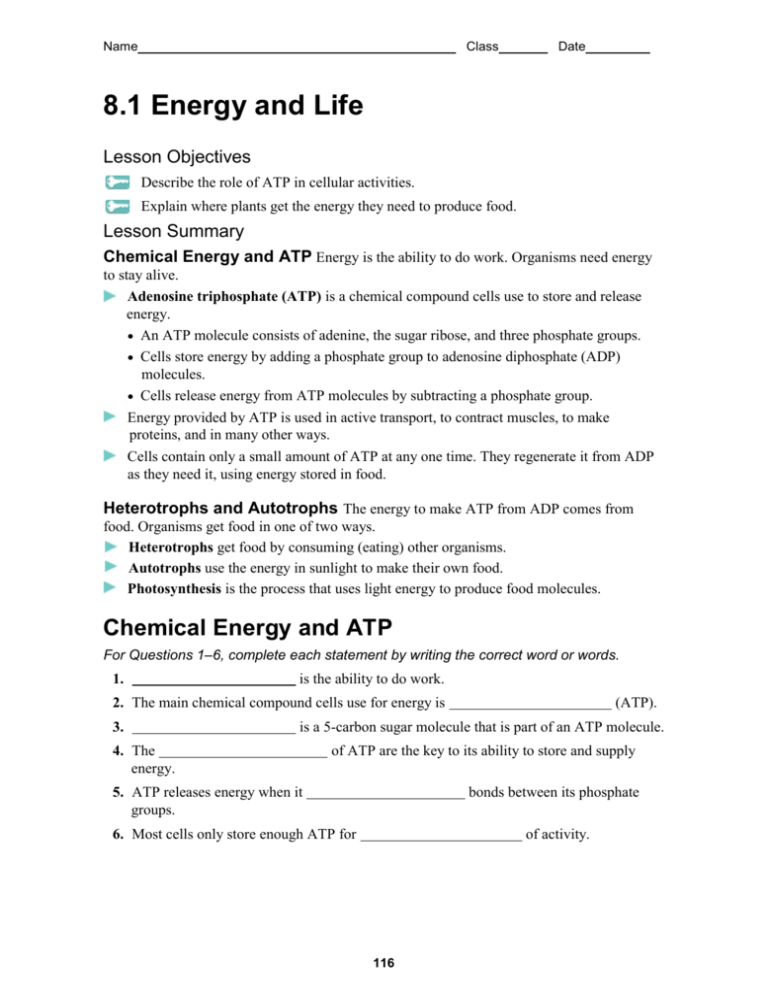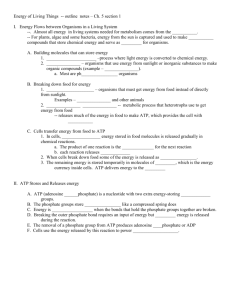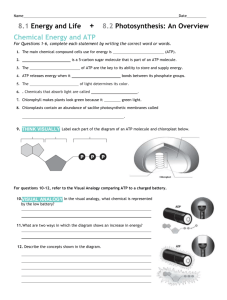Document
advertisement

Name Class Date 8.1 Energy and Life Lesson Objectives Describe the role of ATP in cellular activities. Explain where plants get the energy they need to produce food. Lesson Summary Chemical Energy and ATP Energy is the ability to do work. Organisms need energy to stay alive. Adenosine triphosphate (ATP) is a chemical compound cells use to store and release energy. An ATP molecule consists of adenine, the sugar ribose, and three phosphate groups. Cells store energy by adding a phosphate group to adenosine diphosphate (ADP) molecules. Cells release energy from ATP molecules by subtracting a phosphate group. Energy provided by ATP is used in active transport, to contract muscles, to make proteins, and in many other ways. Cells contain only a small amount of ATP at any one time. They regenerate it from ADP as they need it, using energy stored in food. Heterotrophs and Autotrophs The energy to make ATP from ADP comes from food. Organisms get food in one of two ways. Heterotrophs get food by consuming (eating) other organisms. Autotrophs use the energy in sunlight to make their own food. Photosynthesis is the process that uses light energy to produce food molecules. Chemical Energy and ATP For Questions 1–6, complete each statement by writing the correct word or words. 1. is the ability to do work. 2. The main chemical compound cells use for energy is 3. (ATP). is a 5-carbon sugar molecule that is part of an ATP molecule. 4. The energy. of ATP are the key to its ability to store and supply 5. ATP releases energy when it groups. bonds between its phosphate 6. Most cells only store enough ATP for of activity. 116 Name Class Date 7. THINK VISUALLY Label each part of the diagram of an ATP molecule below. For Questions 8–10, refer to the Visual Analogy comparing ATP to a charged battery. 8. VISUAL ANALOGY In the visual analogy, what chemical is represented by the low battery? 9. What are two ways in which the diagram shows an increase in energy? 10. Describe the concepts shown in the diagram. 11. What are two ways in which cells use the energy temporarily stored in ATP? 12. Energy is needed to add a third phosphate group to ADP to make ATP. What is a cell’s source of this energy? 117 Name Class Date Heterotrophs and Autotrophs For Questions 13–17, write True if the statement is true. If the statement is false, change the underlined word or words to make the statement true. 13. All heterotrophs must eat food to get energy. 14. Autotrophs do not need to eat food because they make food. 15. The energy in food originally came from ATP. 16. The term photosynthesis means “pulling apart with light” in Greek. 17. The energy of sunlight is stored in the chemical bonds of carbohydrates. 18. Complete the table comparing two types of organisms. Autotrophs and Heterotrophs Type Description Examples Autotrophs Heterotrophs Apply the Big idea 19. Suppose that you ate a hamburger on a wheat roll with lettuce, tomatoes, and onions for lunch. As you ate, you took in food molecules from plants and animals. Explain why all the energy in the food molecules of this hamburger could be traced back to the sun. 118







